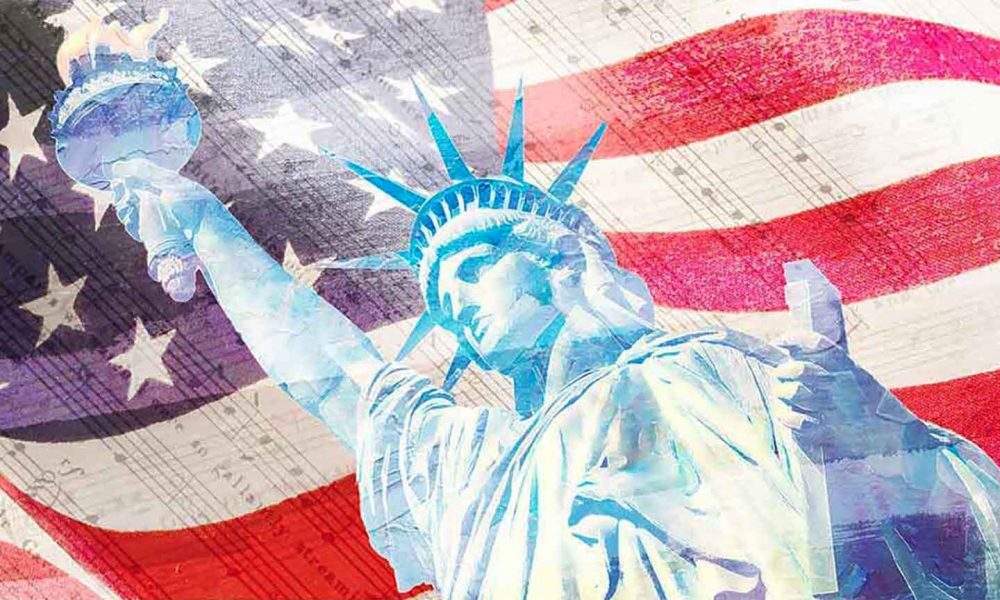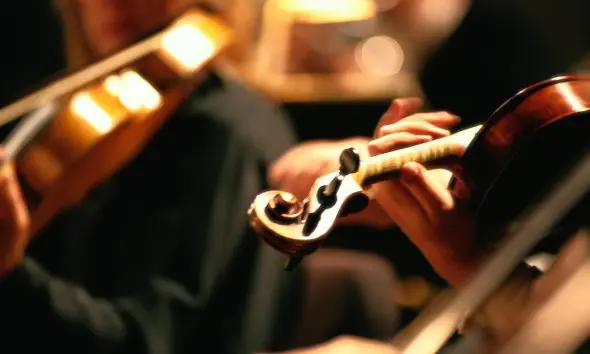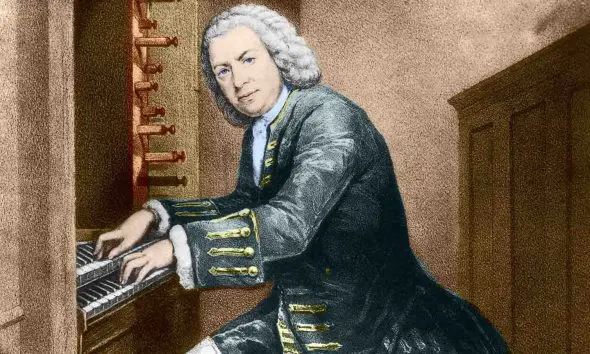Best Classical Music For Independence Day
Discover our selection of the best classical music for Independence Day featuring 20 masterpieces celebrating the United States of America.

Independence Day in the United States of America celebrates the declaration of independence from Great Britain, proclaiming that the thirteen American colonies were no longer subordinate to or subjects of King George 111. Representatives of the thirteen colonies (the Second Continental Congress) actually voted to declare independence on 2 July 1776 but only declared it publicly two days later. The occasion is traditionally marked by parades, marches, fireworks, concerts, picnics and family reunions. This celebratory selection of music reflects what is a joyous event – with a few looks over the shoulder at the country’s past, its history and its foundation by immigrants. Scroll down to discover our selection of the best pieces of classical music for Independence Day.
20: The Liberty Bell – Sousa
A march by John Philip Sousa that lives up to his famous dictum that “a march should make a man with a wooden leg step out”. The Liberty Bell was actually written for Sousa’s unfinished operetta The Devil’s Deputy. When Sousa and his band manager visited the Columbian Exposition in Chicago – a world fare held to mark the 400th anniversary of Columbus’s arrival in the New World – they saw a spectacle entitled America in which the Liberty Bell was lowered. The manager suggested using The Liberty Bell as a title for the unused march. Sousa agreed.
19: Variations on America – Ives
The tune of the British national anthem has been purloined by several countries over the years. Americans sing it to the words My Country, ‘Tis of Thee by Samuel Francis Smith (1808-95) first performed as a children’s Independence Day celebration in Boston in 1831. These variations on the British national anthem were composed by Charles Ives at the age of 17 for the 1892 Independence Day celebrations (though he premiered the work five months earlier). They remained unpublished until 1949. Ives’s bitonal clashes and quirky rhythmic jolts make the piece seem intentionally comic (the young composer apparently meant it to be taken seriously) but it remains a challenging and effective part of the modern organist’s repertoire – and always brings the house down.
18: ‘On The Trail’ from the Grand Canyon Suite – Grofé
Originally entitled Five Pictures of the Grand Canyon, this suite for orchestra is by Ferde Grofé (1892-1972), the man who famously orchestrated Gershwin’s Rhapsody in Blue. Grofé was bandleader Paul Whiteman’s in-house arranger and it was Whiteman’s band that gave the premiere in November 1931 of this quintessential sequence of American tone poems: ‘Sunrise’, ‘Painted Desert’, ‘On the Trail’, ‘Sunset’ and finally the magnificent ‘Cloudburst’.
17: Souvenir d’Amérique, Variations Burlesques sur ‘Yankee Doodle’ – Vieuxtemps
Yankee Doodle is a patriotic American song (and children’s nursery rhyme) that became popular even before the American Revolution. The tune, however, goes back to Medieval times in Europe, its exact origin lost in the mists of time. So it made good business sense for the Belgian virtuoso violinist and composer Henri Vieuxtemps (1820-81) to present the tune as an encore during his 1843 tour of the United States. It is usually heard with piano accompaniment but is arguably even more thrilling when played unaccompanied – a real tour de force.
16: Strike Up The Band – Gershwin
Strike Up the Band is the title song of a 1927 musical of the same name by the Gershwin brothers, George and Ira. Ira revealed that his brother had had four unsuccessful attempts at setting the lyrics of Strike Up the Band. George usually wrote at the piano. On this occasion, it seems, he was lying in bed in a hotel in Chicago when the tune came to him in the middle of the night – complete. He got out of bed, sat down at the piano (there was always one wherever he stayed) and played it exactly as the song is now known. That’s what you call inspiration!
15: All Rise – Marsalis
Commissioned by the New York Philharmonic and Kurt Masur who premièred the work in December 1999, All Rise is a remarkable, unselfconscious fusion of many different musical styles, elements and textures. Dominated by what can be described loosely as the Big Band sound, these include folk song, jazz, gospel, Latin dances, ragtime and spirituals. Mahler, Ellington, Stravinsky and Ives, get a look in. It’s a huge 12-movement work that lasts a little under two hours, separated into three sections of four movements. The composer tells us the first four of these are concerned, “with birth and self-discovery; they are joyous. The second four are concerned with mistakes, pain, sacrifice and redemption. They are sombre and poignant. The last four are concerned with maturity and joy”.
14: America The Beautiful – Bates / Ward
A second national anthem, one of the best pieces of classical music for Independence Day, has words written by a 33 year-old English professor at Wellesley College named Katherine Lee Bates. This famous patriotic song, originally entitled Pikes Peak, a mountain from the top of which Bates took in the majestic view of the Great Plains below and inspired the poem. It was, appropriately enough, first published on the Fourth of July 1895 (in a church periodical) and subsequently revised in 1904 and 1911. The tune had been written 13 years earlier for an entirely different verse by Samuel A Ward, an organist and choirmaster in Newark, New Jersey. Bates’s verse and Ward’s melody were married in 1910, seven years after Ward’s death. He never knew how famous his tune had become. Bates survived till 1929. The two never met.
13: ‘Simple Gifts’ from Appalachian Spring – Copland
Aaron Copland’s Appalachian Spring, one of the best pieces of classical music for Independence Day, exists in four versions: the original ballet score dating from 1944 (13-player complete), 1945 (orchestral suite), 1954 (orchestral complete) and 1972 (13-player suite). Its best known (and much loved) section is the five variations on a tune known as the ‘Shaker Hymn’ or ‘Simple Gifts’ composed in 1848 by Shaker Elder Joseph Brackett. The same tune is also now widely known after its use by Sydney Carter for his 1963 hymn ‘Lord of the Dance’. Copland published independent arrangements of this section for band (1958) and orchestra (1967) titled Variations on a Shaker Melody.
12: The Big Country (theme) – Moross
The title music for William Wyler’s classic 1958 western conjures up the wide empty spaces of America more effectively than almost any other. It was composed after the composer took a walk in the flatlands around Albuquerque, New Mexico, during a visit in October 1936, shortly before he moved to Hollywood. The music was nominated for an Academy Award for Best Original Score, but not one in a hundred could name the composer of this iconic piece of Americana. He was Jerome Moross (1913-83).
11: Union: Paraphrase de Concert on National Airs – Gottschalk
This synthesis of patriotic airs, one of the best pieces of classical music for Independence Day, is by Louis Moreau Gottschalk (1829-69), the first American-born concert pianist of note. It was first performed in New York on Washington’s birthday, 1862, and excited its auditors to frenzied enthusiasm, appearing as it did after one year of civil war. Amid cannonades and grapeshot emerges a disguised, minor key Yankee Doodle, then a beautiful harmonization of The Star-Spangled Banner and Hail Columbia, the latter triumphantly juxtaposed at the last with Yankee Doodle in the major. It is dedicated to General George McClellan. Gottschalk, though a Southerner, was a staunch abolitionist—he had freed all his family’s slaves on the death of his father—and played this fantasy to President and Mrs Lincoln in 1864.
10: ‘Humor’ from Afro-American Symphony – Still
Still’s Symphony No. 1 was the first symphony by a black composer to be played by an American orchestra. He began sketching it in 1924. “It was not until the Depression struck,” he revealed later, “that I went jobless long enough to let the Symphony take shape. In 1930 I rented a room in a quiet building not far from my home in New York and began to work.” The symphony was finished in two months and was premiered in 1931 by the Rochester Philharmonic. Today, it is one of the most popular of all American symphonies and one of the best pieces of classical music for Independence Day.
9: Seventy-Six Trombones – Willson (arr. Anderson)
This rousing show tune comes from the 1957 musical The Music Man which has book, lyrics and music by Meredith Willson (1902-84), an American flutist (he played in Sousa’s band from 1921-23), composer, conductor, musical arranger, bandleader, playwright, and author. His contemporary Leroy Anderson (1908-75), described by film composer John Williams as “one of the great American masters of light music”, made a witty arrangement of Seventy-Six Trombones incorporating snatches of other popular marches including National Emblem, Under the Blue and Yellow Flag (a Swedish march), and Sousa’s The Stars and Stripes Forever and The Washington Post.
8: Battle Hymn of the Republic – Howe / Trad.
When the tune for this great hymn came into existence and who exactly wrote it are uncertain – there are several claimants – but it was originally associated with the marching song John Brown’s Body (John Brown was a militant abolitionist who was hanged for treason in 1859 after a failed slave insurrection). The words of the hymn, also known as Mine Eyes Have Seen the Glory, were penned by Brown’s fellow abolitionist Julia Ward Howe (1819-1910) and first published in the February 1862 edition of the Atlantic Monthly. ‘Glory, glory, hallelujah!’
7: ‘Largo’ from Symphony No 9 ‘From the New World’ – Dvořák
The themes of this much-loved symphony, one of the best pieces of classical music for Independence Day, are all Dvořák’s own, though he had so thoroughly absorbed African American folk melodies during his time in America that he convinces you that you are listening to genuine spirituals. The famous slow movement is one of the most popular works of all classical music, but the whole work has never lost its appeal since its first performance in New York by the New York Philharmonic in 1893. “I felt like a king in my box,” wrote Dvořák at the time.
6: American Salute – Gould
Written in 1942 in the early days of World War II, the piece was composed at the request of a government radio programme producer who wanted a “salute to America”. The composer insisted that he had no idea that the work was destined to become a classic. Gould (1913-96) also composed American Caprice, American Sing: Settings of Folk Songs, American Symphonette No. 2, American Youth March and Americana.
5: Rhapsody in Blue – Gershwin
Marches and hymns excepted, the most frequently performed piece of American music was composed in 1924 by George Gershwin. It was written in the space of a few weeks at the behest of Paul Whiteman, the self-styled ‘King of Jazz’, and premiered in front of the world’s musical elite with triumphant success. The opening clarinet glissando is one of the most famous introductions of any classical work, the big theme halfway through one of the most loved. Just as a Johann Strauss 11 waltz conjures up fin de siècle Vienna, so does Gershwin’s Rhapsody in Blue, one of the best pieces of classical music for Independence Day, define America in the 1920s.
4: Fanfare for the Common Man – Copland
Another work by the American composer Aaron Copland, this one written at the request of Eugene Goossens, conductor of the Cincinnati Symphony Orchestra. During World War I, Goossens had asked British composers for a fanfare to begin each orchestral concert and now, with World War 11, wanted to replicate the successful idea in America. Sixteen of these fanfares were written, Copland’s being the only one that remains in the repertoire. The title? That was inspired by a speech given in 1942 by the Vice President, Henry A Wallace, in which he talked of “the Century of the Common Man”. Copland used the fanfare as the theme for the fourth movement of his Symphony No. 3 composed in 1944 and 1946.
3: The Star-Spangled Banner – Smith / Key
America’s official national anthem. The words were written by Francis Scott Key, a 35-year-old American lawyer who witnessed the Battle of Baltimore in September 1814 as the British guns pounded Fort McHenry. By “the dawn’s early light” on September 14, Key saw the American flag – not, as expected, the British Union Jack—flying over the fort, announcing an American victory. “And the rocket’s red glare, the bombs bursting in air, Gave proof through the night that our flag was still there.” He wrote the poem the same day, entitled The Defence of Fort M’Henry. After the poem was published in various newspapers, it was set to the music of, ironically, a popular English tune, To Anacreon in Heaven by John Stafford Smith, the signature tune of London’s all-male social club The Anacreontic Society (Anacreon was an ancient Greek lyric poet, notable for his drinking songs and erotic poems). It was then that people began referring to the song as The Star-Spangled Banner, yet the standardised version known today was only agreed upon in 1917. On 3 March 1931 it was adopted as the US national anthem.
2: The Stars and Stripes Forever – Sousa
Now the official National March of the United States of America, this most famous of the 136 marches by John Philip Sousa was written on Christmas Day 1896 on board an ocean liner. Sousa and his wife were returning from a holiday in Europe. It was first performed at Willow Grove Park near Philadelphia on 14 May 1897 (there is a recording of it made by Sousa himself with his band in 1909). The Stars and Stripes Forever, one of the best pieces of classical music for Independence Day, follows the usual pattern of a Sousa march: arresting introduction followed by three contrasting tunes, all repeated. The final tune here is grandly restated with a famous piccolo obligato on top.
1: Give Me Your Tired – Berlin
This wonderful song says more about America and its aspirations than even a stirring patriotic march. It is an arrangement of Irving Berlin’s setting to music of words inscribed on the Statue of Liberty. It comes from his 1949 Broadway musical Miss Liberty (all about the building of the statue). Berlin was certain the song would become the America national anthem and was disappointed when it did not. The words are by Emma Lazarus (1849-87) from her 1883 poem The New Colossus:
Give me your tired, your poor,
Your huddled masses yearning to breathe free,
The wretched refuse of your teeming shore.
Send these, the homeless, tempest-tossed to me.
I lift my lamp beside the golden door!






